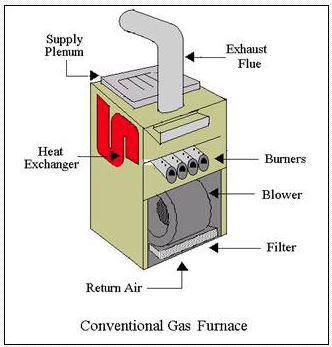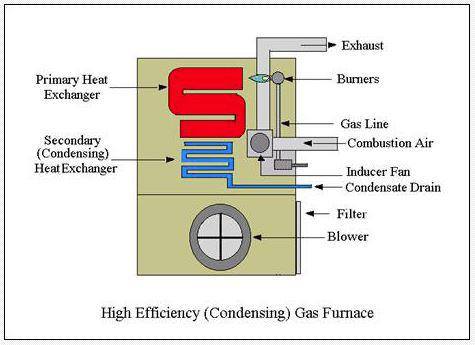What Is A Gas Furnace?
A gas furnace derives heat from burning Propane or Natural Gas. Propane gas is delivered by trucks into a tank located on your property, and that tank has piping connected to it to provide gas to your furnace. Natural Gas is delivered to your home by underground piping throughout your community
When a furnace is consuming gas to get its heat to provide warmth for you and your family, one of the first things that come to mind; how much will that cost? The efficiency of your gas furnace is important to consider to keep your monthly cost under control. Gas furnace efficiency comes as an Annual Fuel Utilization Efficiency or AFUE. The AFUE represents the percentage of the heat available in the fuel that is converted to usable heat for your home. For example, a furnace rated at 80% AFUE will deliver 80% of the heat available in the fuel. The remaining 20% is lost as exhaust up the flue or chimney.
Furnaces are typically constructed in four separate configurations:
- Vertical Up-flow – The furnace sits in a vertical position blowing the warm air up into
the ducts that are connected above the furnace. The return air ducts typically will be connected to the
bottom or bottom side of the furnace. - Vertical Down-flow – – The furnace sits in a vertical position blowing the warm air
down into the ducts that are connected above the furnace. The return air ducts typically will be connected
to the bottom of the furnace. - Vertical Horizontal – The furnace sits in a horizontal/laying down position blowing the
warm air to the side into the ducts that are connected to the furnace. The return air ducts will typically
be connected to the furnace at the end of the furnace opposite of the supply ducts. - Low-boy – The furnace is situated in an area that has a low ceiling (cellar or low
ceiling basement), and the furnace sits in a verticle position blowing the warm air up into the ducts that
are connected above the furnace. The return ducts will be connected to the top of the furnace directly
beside the supply duct.
Standard Efficiency Gas Furnace
The standard efficiency of a gas furnace IN the 1970s and the early 1980s was 70% or less; however, today, the lowest standard is 80+%.
With the standard gas furnace, the gas is consumed through a series of burners, and the heat from the burning gas is collected in what is referred to as a “heat exchanger.” The heat exchanger is the main component or engine of the gas furnace, while the blower moves air across the furnace heat exchanger to provide heat to the associated ducts that are connected to the furnace. Connected to the heat exchanger is the flue piping, which removes the excess heat and the harmful gases that are produced from the burning of the gas. The flue piping is constructed with metal piping and needs to be double-wall construction when passing through a wall or ceiling.
High Efficiency Gas Furnace
The high-efficiency gas furnaces use an additional heat exchanger to extract more heat from the consumption of gas through a burner or burners. These furnaces can utilize so much of the gas to produce heat that very little is wasted. Up to 98% of the gas that is consumed is turned into heat for your home. Often the high-efficiency furnaces are referred to as a condensing gas furnace. The exhaust gases are so cool due to most of the heat is drawn out through the heat exchanger system, that the flue gases condense into water vapor through the process. At peak heating season, the furnace can produce 6 gallons of water condensation. The condensation is acidic, so the associated flue gas vent piping needs to be constructed of a non-corrosive material, and because these gases are so cool, plastic/PVC piping is used to vent the flue gases. The flue gases also need assistance in leaving the heat exchanger because there is little heat to cause them to vent on their own. Condensing gas furnaces utilize a fan that forces the flue gases to be vented through the plastic piping exiting to the outdoors.
The Gas Burner
Gas burners can be staged or modulated to help increase efficiencies. The standard is to have the burners come on full force, but the higher efficiency models often have burners that come on in stages or slowly modulate in BTU output. For example, a 100,000 BTU burner may first come on at 60,000 BTU, and if the home temperature doesn’t reach the desired set point in a reasonable time, the burner will step up to the full 100,000 BTU output. The modulating style gas burner system increases and decreases in very small BTU increments.
The Blower
Blowers produce the air that draws the heat from the heat exchanger and ultimately puts the warm air into your home. The blower can be a single speed, multiple speed, or variable speed. The proper blower will help increase the comfort level of your home and also increase the overall efficiency as well.
Summary
The Gas Furnace is an excellent way to heat your home and keep your entire family cozy warm throughout the cold winter months. The temperatures coming from the registers will feel warm, have a quiet operation, and you can rest easy knowing you can rely on safe efficient comfort. Comfort Plus Services can provide a free heating system analysis. Visit our website to start the process of picking your comfort options or give us a call @ 866-950-COLD (2653).









